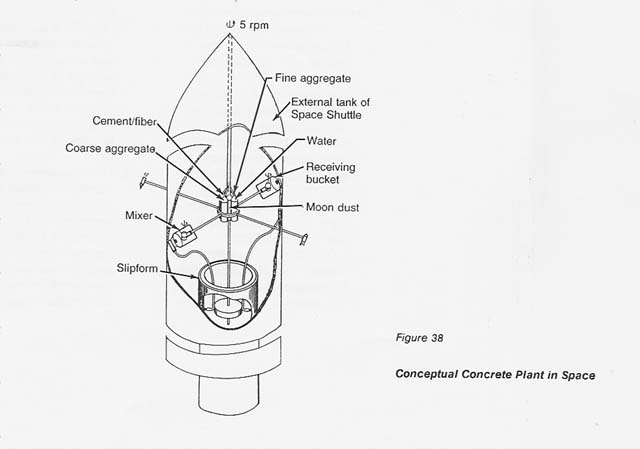
Concrete: Potential Material for Space Station
T. D. Un
Introduction
To build a permanent orbiting space station in the next decade is NASA's most challenging and exciting undertaking. The space station will serve as a center for a vast number of scientific projects. Because of high launch costs, aluminum and fibrous composite materials, light and strong in nature, are being considered for the construction. To my knowledge, concrete has been totally neglected in the search for suitable materials.
In 1981, Construction Technology Laboratories, a division of the Portland Cement Association, initiated a study of the feasibility of using concrete for structural components of a space station. The idea of using concrete in space may seem absurd to many scientists and engineers. Nevertheless, the study shows that concrete is not only suitable but also economical for space station construction.
Concrete
Concrete is basically a mixture of two components: aggregate and cement paste. The paste, composed of Portland cement and water, binds the aggregate into a rocklike mass as it hardens. In general, concrete consists of three parts aggregate and one part paste by weight.
Since the invention of Portland cement in 1824, concrete has been a widely used construction material and a popular subject for study by the engineering community. Using current concrete technology, a compressive strength of 6000 psi [41.4 megapascals (MN/m²)] can easily be attained with the proper mix design. Concrete made with superplasticizer has a strength of 10 000 psi (69 MN/m2), and treatment of superplasticized concrete with silica fume (Malhotra and Carette 1983) raises its strength to 17 000 psi (117 MN/m²).
Reinforced Concrete
The flexural strength of plain concrete is generally low, about 1/10 its compressive strength. However, concrete reinforced with steel rods has found common use in the construction of high-rise buildings, nuclear containment structures, and pressurized liquid nitrogen tanks. The strength design method recommended by the Building Code Requirements for Reinforced Concrete (ACI 318-83) assumes that the concrete takes up the compressive stresses and the reinforcing steel takes up the tensile stresses.
Concrete reinforced with either steel or glass fibers has greatly increased flexural strength, strain energy, and ductility. Test data reveal that concrete reinforced with 4 percent steel fibers by weight
possesses nearly twice the flexural strength of plain concrete (Hanna 1977). Other studies indicate that these fibers act as crack arresters; that is, the fibers restrict the growth of microcracks in concrete (Romualdi and Batson 1963).
Lunar Materials
To produce concrete in space, lunar rocks will make excellent aggregate. Concrete specimens made with terrestrial basalt similar to lunar basalt have been tested in our laboratories. As expected, basalt concretes have compressive strengths of 6000 psi (41.4 MN/m²) and higher. Moon dust, a pozzolanic substance similar to fly ash (a byproduct of coal-fired power plants producing electricity), can be used to reduce cement requirements by as much as 15 percent without degrading concrete quality (McCrone and Deily 1973).
Once a lunar base is established for the extraction of lunar oxygen (Davis 1983), water produced in the oxygen extraction process can be used for making concrete. The hydrogen needed to extract the oxygen may itself be extractable from the lunar soil, where it has been implanted by the solar wind to a concentration of 100 ppm (Carter 1985). However, if hydrogen extraction proves to be economically infeasible, the hydrogen can be brought up from the Earth.
A study of mare basalt and highland anorthosite (NASA CP-2031) brought back by the Apollo 17 astronauts reveals that it is possible to manufacture on the Moon both glass fibers (Subramanian and Austin 1978) and a cement which is relatively high in aluminum oxide (Takashima and Amano 1960) by sintering lunar materials in a solar furnace. Concrete made from this type of cement is strong but crumbles when it absorbs moisture. On the dry Moon, such a cement offers the advantage without the disadvantage.
Because of the low gravity and the lack of an atmosphere on the Moon, the transport of construction materials from the lunar surface to Earth orbit can be accomplished with tremendous energy savings in comparison to shipping them from the Earth's surface (Chapman 1984).
Mixing and Casting
Concrete would be mixed and cast in a Space Shuttle external tank that provides temperature, pressure, and humidity controls. Figure 38 shows a conceptual space concrete plant. Two rockets at the ends of a tube protruding from the module spin the system to provide the desired centrifugal force (0.5 g). Centrifugal force makes conventional mixers usable in a weightless environment.
Concrete materials would be pumped from storage bins through tubes to the mixers. From the intake position, the mixers turn 90° to an upright position and then rotate around their own axes to agitate the mixture. By rotating another 90° so that the feed openings face outward, the mixers allow the fresh concrete to be discharged into receiving buckets, from which spiral mass drivers can pump the wet concrete to the casting location.
After discharging into forms, the concrete would be consolidated, using appropriate vibrators, and finished with large trowels by human operators, working in the shirt-sleeve environment. In terrestrial construction, forms are generally removed 7 days after casting. However, a low-gravity environment will put less stress on the curing concrete, and therefore it will be possible to shorten the 7 -day requirement to 1 day by decreasing the spin rate of the system. Since water will be expensive to manufacture in space, condensers can be utilized to capture the moisture evaporated during the curing period. As soon as the concrete has dried sufficiently, the structure is ready to be moved out of the module. The application of slip-forming techniques will make it possible to build a continuous cylindrical space station of any size.
